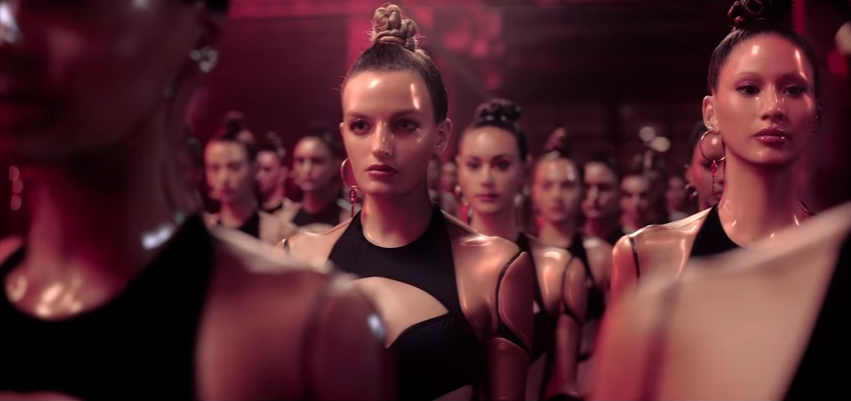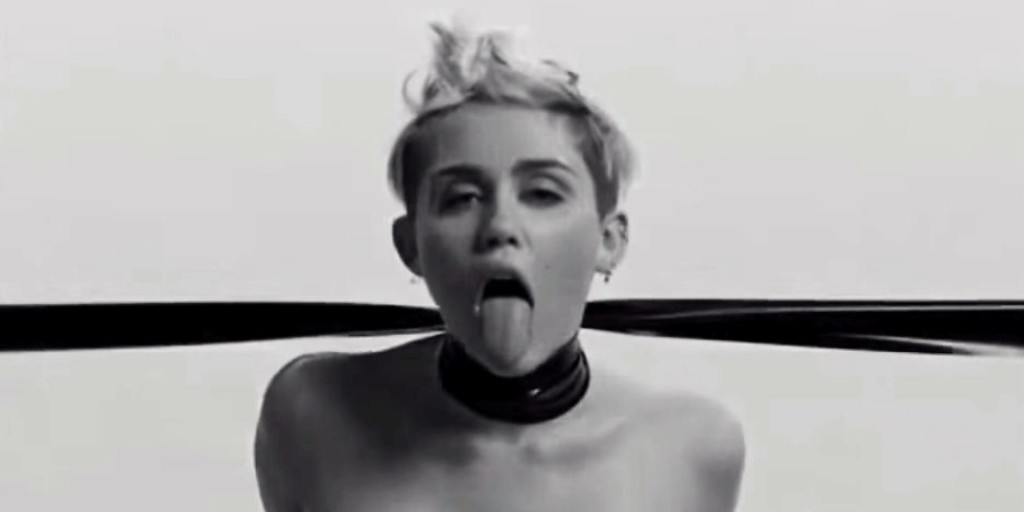In her latest music video, for the single “Look What You Made Me Do,” during one scene, Taylor Swift appears in the guise of a dominatrix, holding a riding crop whip as she stands in front of a vast array of mesmerized semi-robotic women – all wearing a strikingly similar outfit. Recently, at the Dore Alley Street Fair in San Francisco, a rather notorious gathering of the BDSM subculture, I noticed (returning as a missionary) that the population most know, for celebrating the freedoms of the sexual revolution, the “gay” male community, is widely engaged in various practices which reenact forms of humiliation, restraint, and slavery. Also, exactly a month earlier, at the far more mainstream and corporate sponsored San Francisco “Pride” Parade, the outward signs of bondage fetishism were somewhat subdued, but still altogether apparent: men in chest harnesses, wearing leather police caps, with dog collars and chains around their necks. In the midst of sexual chaos and fluidity, there is this instinctual need to impose order.
The first manifestation of bondage in pop-culture appeared during the political, economic, and social unrest of the 1970s. In 1972, at the height of the “sexual revolution,” in the case Eisenstadt v. Baird, the U.S. Supreme Court legalized the possession of contraceptives for unmarried individuals; the following year, in Roe v. Wade, the Court ruled in favor of a woman’s right to have an abortion; also in 1973, the American Psychological Association removed homosexuality from the list of accepted mental disorders. The divorce rate in the United States more than doubled from 22% in 1960 to 48% in 1975. Simultaneously, although it was the middle of the so-called “Golden Age” or pornography, a time when hardcore films received serious consideration and criticism, a whole genre of motion-pictures swerved heavily into the realm of cruelty and punishment.
One of the most notorious examples are the horrid and violent “Ilsa” movie series, beginning in 1975, which detailed the sadomasochistic exploits of a female commandant who oversees sadistic experiments at her prison camp; these often gruesome sexploitation films were actually derivative of a slightly earlier genre: the women-in-prison movies of the late-1960s and early-70s. But in a rare example of supposed high-culture influencing the marginal, the direct precedent of the bondage sexploitation film is the controversial and ugly 1974 Liliana Cavani art-house movie “The Night Porter” which told the story of an ex-Nazi officer and concentration camp photographer who begins a sadomasochistic relationship with one of his former victims. In part, the depictions of confinement and control formed a sort of subliminal reaction against the sexual revolution which most deeply affected the intimate-lives of young women who were no longer subject to traditional restrictions such as curfews at single-sex college dormitories and strict guidelines regulating the admittance of male visitors.
Throughout the same time period, an equivalent sort of dynamic was also playing out in Italy were wide-spread corruption and labor unrest unleashed a series of bloody terrorist attacks and assassinations. In addition, after the proposed innovations and reforms instituted by the Second Vatican Council, the Catholic Church held a considerably less central position in Italian politics and daily life. In this milieu of uncertainty, a string of extremely perverse films became wildly popular which combined sado-masochism with religious profanation. Dubbed “nunsploitation,” these movies are similar to the sexploitation and women-in-prison films that were simultaneously popular in the English-speaking world in that they depicted the same sort of confinement and punishment for those who questioned authority and order. This phenomena somewhat brings to mind the cult of the flagellants who processed through Medieval Western Europe, beating themselves bloody, when the continent was submerged in the near-anarchy and horrors of the Black Death.
During the late-1970s and early-80s, when similar conditions of massive economic and societal upheaval gripped the United Kingdom, facilitating the rise of Margaret Thatcher, the gender-bender disruption caused by the New Romantics created a counter-force within New-Wave which moved heavily in the direction of bondage and disciple. It’s most obvious in the song “Sweet Dreams” by the Eurythmics and the kinky visuals surrounding Duran, Duran and Depeche Mode. The chaos and confusion of modern life, symbolized by wavering borders separating the genders, necessitated an almost fascist caricturization of masculinity. For example, in the original uncensored version of the accompanying music video to the hit-single “Relax” by Frankie Goes to Hollywood, the rather ephebic lead-singer is manhandled at a gay bar by a cadre of sweaty leather-clad ruffians who spit in everyone’s face.
In the Baroque period, following the turbulence of the Reformation, appeared a flourishing of sadism in the visual arts; paintings that illustrate in grisly and sometimes lurid details surrounding the martyrdom of the Saints were commonplace. It was a peculiar sort of looking back at other unstable periods of history, the reigns of the Roman Emperors Nero, Commodus, and Diocletian, when the blood-sport slaughter of the Coliseum mesmerized the masses; therefore, it’s not surprising that modern bondage paraphernalia looks like a slight reconceptualization of gladiatorial garb.
With the advent of AIDS in the early-80s, the BDSM aesthetic entered the dominion of high-art through the work of gay photographer Robert Mapplethorpe. Although Mapplethorpe himself succumbed to the disease in 1989 at age 42, his highly pornographic shots of genital mutilation, men in full body rubber-suits, and urination almost mainstreamed extreme sexual practices with large posthumous exhibitions of his work at such prestigious institutions at the Whitney Museum and the Guggenheim. But most importantly, the stark black and white images he created are a complete contrast to the sometimes orgiastic and frenzied disco and punk scenes of 1970s New York City during which many of them were created. The strict sense of organization and symmetry in Mapplethorpe’s bondage photos is an attempt construct order out of chaos.
A year after the death of Mapplethorpe, Madonna released the accompanying music video for her single “Justify My Love.” Shot in the same crystalline clear monochromatic style as Mapplethorpe, Madonna also borrowed heavily from “The Night Porter,” incorporating some of the film’s most shocking moments involving a nearly nude female wearing a black leather police cap; these motifs of fetishized militaristic police-state uniforms had already entered the gay lexicon as witnessed by the character of the leather-man from “The Village People.”
At the very beginning of “Justify My Life,” Madonna wanders helplessly in a semi-stupor through a near deserted hotel. As she staggers down a long corridor, the viewer glimpses into each room – creating a cascading peep-show effect that harkens back to Madonna’s earlier video for “Open My Heart” in which she played a stripper costumed in Jean Paul Gaultier’s bondage inspired corsets. Like the gay bathhouse and sex-clubs, with its endless network of passageways and cubicles where each room contains an awaiting nameless sexual adventure, in “Justify My Love,” the wayward Madonna finds a narcosis of sexual hierarchy in an age of AIDS and social unrest. The video ends with a quote from Madonna herself:
Poor is the man whose pleasures depend on the permission of another.
But this becomes the ultimate irony as the video is all about subjugation and relinquishing the freedom to, according to the contemporary pop-culture anti-hero Aleister Crowley – “do why thou wilt.” Over two decades later, Madonna is still conflicted when she begs forgiveness from God in the 2012 song “Girl Gone Wild.” The previous year, Rihanna tried to look sexy, but appeared entrapped in the video for “S&M;” singing: “There’s no way I’m turning back…The affliction of the feeling leaves me wanting more…” Her hopeless desperation mirrors the complaint of the porn and gay male sex addict that can’t seem to control their impulsive behavior. For a few seconds, various headlines about Rihanna scrawl across the screen; one reads: “Daddy Issues.” It’s almost an indictment of blame, Rihanna’s father was a drug addict during her childhood; this is comparable to Swift’s proclamation: “Look What You Made Me Do.”
A near neurosis appears in the highly informative collection of essays by gay men about their fathers in the book: “The Man I Might Become.” A rare glimpse into the relationships between fathers and sons, each story reveals the inner turmoil and often chaotic family relationships present in the prehomosexual boy with one man stating this about his father: “All right. If I was a sissy, it was his fault.”
A well known drag queen said: “Being gay is the best way to get back at your parents.”
Only, for some, “Justify My Love” went too far and MTV refused to air it. But Madonna had her revenge in 1992 when she published the hardcore photographic memoir “Sex.” The book contained back and white photos in which Madonna enacted primarily bondage themed scenarios. But by the time Madonna appeared in skin-tight latex and bound to a chair two years later for the video “Human Nature,” the public didn’t have a gasp left in them. After that, the relentless ascendancy of her career was over. For the second half of the 1990s saw the emergence of the internet and the proliferation of on-line pornography. From that point onward, the ability to offend an increasingly jaded audience became extremely difficult.
Around the Millennium, a powerful pop-culture phenomena emerged – that of the girl-next-door gone bad. This usually entailed a former female Mouseketeer becoming a singing star and then transforming into an icon of teenage sexual freedom and exploration. Yet, the image became darker and far more sinister than their initial incarnations as midriff bearing ingénues – with Britney Spears going full dominatrix in a bright red cat-suit during the music video for “Oops!…I Did It Again” from the year 2000 and Christina Aguilera literally traversing through a hellish BDSM playground in “Dirrty” from 2002.
While far younger than Madonna when they reached a saturation point of over-exposure, Spears and Aguilera couldn’t maintain the level of perversity to hold the fascination of the consumer and a collective cultural boredom began to set-in. Therefore, a new generation of women emerged who were willing to deliberately leap over the imaginary, but collectively acknowledged, boundary that separated mainstream entertainment from pornography.
The first was Lady Gaga, a middle-class Italian-American Catholic school-girl, like Madonna before her, who rebelled and immersed herself in the gay sexual landscape of New York City, and Miley Cyrus – the ultimate ex-Disney child actress turned gender-fluid revolutionary. So far the more successful of the two, in 2010, Lady Gaga became the most discussed woman in the world largely because of the music video for the song “Bad Romance.” At the time, it was the most-viewed video in YouTube history. The main accomplishment of the video was its ability to unsettle in the first few minutes: Lady Gaga, in a white rubber bondage mummification costume, crawls out of a quasi-sensory deprivation tank, and begins a Michael Jackson inspired “Thriller” dance routine – all the while reaming completely blindfolded. Later, she is sold to the highest bidder during a sex slave auction. In its interplay between excess and severity – Lady Gaga created an odd space of symbolic orderliness and clinical sterility; it’s about the desire to be controlled and to control. In a chaotic world devoid of sexual barriers, humanity longs for structure; in some, this swerves very hard towards an ethos where choices are willingly abdicated and removed.
But like Spears and Aguilera, the quick rise of Lady Gaga doomed her to eventual irrelevance. When her position began to slip, Lady Gaga became increasingly desperate and splattered herself with blood in order to gain attention. Meanwhile, in 2014, Miley Cyrus couldn’t cause much of a stir by starring in a repulsive bondage-themed short-film “Tongue-Tied. The following year, she participated in a shoot for photographer Terry Richardson, a talentless Mapplethorpe wannabe, fully naked and wearing strap-on gear. For a woman who once espoused her own “gender-fluid” identity, it’s a conspicuous yearning for certainty and restrictions that becomes self-mocking and actually emphasizes the obvious biological and physiological differences between men and women. The structure of sex replaces the missing structure of the absent or dysfunctional family.
From Madonna to Lady Gaga, pop-stars who became so-called gay-icons often drew their primary inspiration from gay male culture. Beginning with Judy Garland, gay men are intensely faithful to certain female entertainers above all those with theatrical private lives and a history of abuse or trauma. There is often a shared commiseration in suffering. This is due probably because the first to espouse, and the most significantly damaged by the sexual revolution, where gay men. Not coincidentally, very early on gay men also exhibited the tendency to classify and highly regiment sexual practices even when confronted with open unrestricted availability: from elaborate and complicated non-verbal facial cues passed among knowing participants in a public male lavatory to the mechanical almost android-like headless profiles on the hook-up app Grindr. Here, sex invariably became meaningless and arbitrary hence it’s eventual fixation with stratification from top to bottom and the need for “daddy” authority figures as sexual partners. Later, women invariably felt the same sense of being used combined with a curious dissatisfaction. Consequently, supposedly well-adjusted professional women, unencumbered by the threat of an unplanned pregnancy, made “Fifty Shades of Grey” a runaway bestseller. Earlier, the desire to renunciate sexual freedoms were repeatedly explored in dime-store romance novels which typically depicted the kidnapping and ravishment of a formerly self-assured and complacent, but unhappy, woman by a rogue hyper-masculine adventurer or pirate.
In “Look What You Made Me Do,” Taylor Swift, the once skinny country-singer in pigtails now Hollywood glamour it-girl, subconsciously combines and subsequently exposes many of these same themes: the shallowness of sexual diversions, sexual enslavement, and the corruption of innocence and beauty. Yet recently Swift’s image is indeterminate and always in flux, as witnessed at the end of the video when her various personas are lined-up and arguing with each other; Katy Perry is currently morphing from one tired look (aping Cyrus’ already done bleached-blond short hair-cut) to another in a quest to elicit curiosity; she can’t. This is another sign that society and culture remains in crisis and as economic concerns worsen and once stabilizing societal structures continue to decline, the severity of human suffering will multiple, resulting in an increase and intensification of sadism.
“‘For me everything is permissible’; maybe, but not everything does good. True, for me everything is permissible, but I am determined not to be dominated by anything.” (1 Cor. 6:12)









